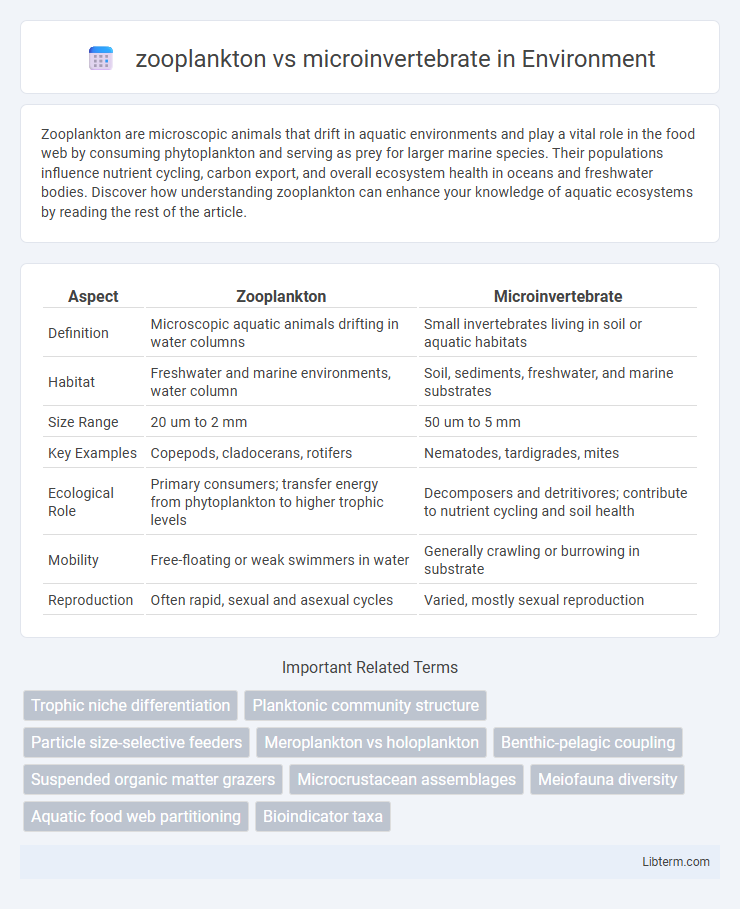Zooplankton are microscopic animals that drift in aquatic environments and play a vital role in the food web by consuming phytoplankton and serving as prey for larger marine species. Their populations influence nutrient cycling, carbon export, and overall ecosystem health in oceans and freshwater bodies. Discover how understanding zooplankton can enhance your knowledge of aquatic ecosystems by reading the rest of the article.
Table of Comparison
| Aspect | Zooplankton | Microinvertebrate |
|---|---|---|
| Definition | Microscopic aquatic animals drifting in water columns | Small invertebrates living in soil or aquatic habitats |
| Habitat | Freshwater and marine environments, water column | Soil, sediments, freshwater, and marine substrates |
| Size Range | 20 um to 2 mm | 50 um to 5 mm |
| Key Examples | Copepods, cladocerans, rotifers | Nematodes, tardigrades, mites |
| Ecological Role | Primary consumers; transfer energy from phytoplankton to higher trophic levels | Decomposers and detritivores; contribute to nutrient cycling and soil health |
| Mobility | Free-floating or weak swimmers in water | Generally crawling or burrowing in substrate |
| Reproduction | Often rapid, sexual and asexual cycles | Varied, mostly sexual reproduction |
Introduction to Zooplankton and Microinvertebrates
Zooplankton are microscopic animals drifting in aquatic environments, playing a crucial role in aquatic food webs by consuming phytoplankton and serving as prey for larger species. Microinvertebrates, including tiny organisms such as rotifers, nematodes, and small crustaceans, contribute to nutrient cycling and sediment dynamics in freshwater and marine ecosystems. Both groups are essential for maintaining ecosystem balance, influencing nutrient availability and energy transfer across trophic levels.
Defining Zooplankton: Characteristics and Types
Zooplankton are small, often microscopic aquatic animals that drift in water columns and serve as crucial components of marine and freshwater food webs. They include diverse groups such as copepods, krill, and protozoans, characterized by their ability to swim weakly and their heterotrophic feeding habits. Unlike microinvertebrates, which are generally benthic or substrate-associated and include organisms like nematodes and tardigrades, zooplankton primarily occupy pelagic zones and play pivotal roles in nutrient cycling and energy transfer.
What Are Microinvertebrates? Key Features and Groups
Microinvertebrates are tiny, often microscopic animals found in aquatic and terrestrial ecosystems, including groups such as nematodes, rotifers, tardigrades, and microcrustaceans. Key features of microinvertebrates include their small size, simple body structure, and diverse feeding strategies ranging from detritivory to predation, playing critical roles in nutrient cycling and food webs. Unlike zooplankton, which primarily consists of drifting aquatic organisms, microinvertebrates inhabit both sediment and water columns, contributing to ecosystem functioning across various habitats.
Habitat Differences: Where They Live and Thrive
Zooplankton primarily inhabit open water columns in freshwater and marine environments, thriving in pelagic zones with varying depths and temperatures. Microinvertebrates often reside in benthic habitats, including sediments, leaf litter, and aquatic vegetation, where they find shelter and organic material for sustenance. These habitat differences influence their ecological roles, with zooplankton acting as key consumers in water columns and microinvertebrates contributing to nutrient cycling in benthic ecosystems.
Life Cycles and Reproduction Comparison
Zooplankton exhibit diverse life cycles, often including multiple developmental stages such as nauplius, copepodite, and adult phases, with reproduction primarily characterized by rapid egg production and sometimes parthenogenesis in species like rotifers. Microinvertebrates, including nematodes and tardigrades, generally have simpler life cycles with direct development, where offspring resemble miniature adults, and their reproduction can be sexual or asexual depending on environmental conditions. The reproductive strategies of zooplankton emphasize high fecundity and dispersal potential, while microinvertebrates balance reproductive efficiency with survival in microhabitats.
Role in Aquatic Food Webs
Zooplankton serve as primary consumers that feed on phytoplankton and are crucial prey for larger aquatic organisms like fish and amphibians. Microinvertebrates, including small crustaceans and insect larvae, function as both detritivores and predators, recycling nutrients and controlling microbial populations. Together, zooplankton and microinvertebrates form essential trophic links that transfer energy from primary producers to higher trophic levels in aquatic ecosystems.
Feeding Habits and Ecological Niches
Zooplankton primarily feed on phytoplankton, bacteria, and detritus, occupying the pelagic zone where they serve as a critical link in aquatic food webs by transferring energy to higher trophic levels. Microinvertebrates consume a diverse range of organic material including decomposing plant matter, microorganisms, and small protozoans, often inhabiting benthic substrates and contributing significantly to nutrient recycling and sediment processing. Both groups exhibit specialized feeding adaptations that enable them to exploit distinct ecological niches, maintaining ecosystem balance in freshwater and marine environments.
Importance in Ecosystem Health and Monitoring
Zooplankton serve as critical bioindicators for assessing aquatic ecosystem health due to their rapid response to environmental changes and their role in nutrient cycling. Microinvertebrates contribute significantly to the decomposition of organic matter and are essential for maintaining soil and sediment quality, making them valuable indicators for terrestrial and freshwater ecosystem monitoring. Monitoring both zooplankton and microinvertebrate populations provides comprehensive insights into ecosystem stability, pollution impacts, and biodiversity conservation efforts.
Applications in Scientific Research
Zooplankton serve as key bioindicators in aquatic ecosystem health studies, providing valuable data on water quality and trophic dynamics. Microinvertebrates, including benthic species, are widely used in sediment toxicity assessments and pollution monitoring due to their sensitivity to environmental contaminants. Both groups contribute to paleolimnology and climate change research by offering insights into historical ecological conditions through fossil records.
Key Differences and Similarities: Zooplankton vs Microinvertebrates
Zooplankton are primarily microscopic drifting animals found in aquatic environments, playing a crucial role in the marine food web by consuming phytoplankton and serving as prey for larger species, whereas microinvertebrates include a broader group of small, often benthic invertebrates such as nematodes and micro-crustaceans that inhabit sediments and surfaces. Both zooplankton and microinvertebrates contribute significantly to nutrient cycling and energy transfer in ecosystems, exhibiting diverse feeding habits and adaptive strategies despite differences in habitat and mobility. Key differences also include zooplankton's mostly planktonic lifestyle versus the typically sedentary or substrate-associated existence of microinvertebrates.
zooplankton Infographic

 libterm.com
libterm.com